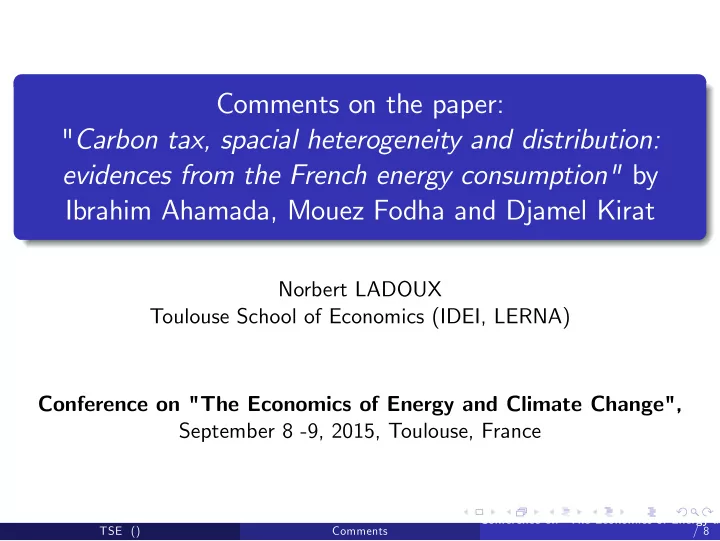

Comments on the paper: " Carbon tax, spacial heterogeneity and distribution: evidences from the French energy consumption" by Ibrahim Ahamada, Mouez Fodha and Djamel Kirat Norbert LADOUX Toulouse School of Economics (IDEI, LERNA) Conference on "The Economics of Energy and Climate Change", September 8 -9, 2015, Toulouse, France Conference on "The Economics of Energy and TSE () Comments / 8
Contributions of the paper To check if the data satisfy the Environmental Kuznets Curve (EKC) hypothesis (inverted U-shaped relationship between activity and pollutant emissions) To analyze the redistributive consequences of a carbon tax among different regions in France in order to propose different tax schemes allowing to improve acceptability of carbon pricing Conference on "The Economics of Energy and TSE () Comments / 8
The econometric model The model is based on the following equation it + α 3 P gas α 0 + α 1 Y it + α 2 Y 2 + α 4 P oil E it = t t + α 5 Tech it + α 6 T it + α 7 G it + ε it E it is per capita CO2 emissions in region i (22 regions) at time period t (10 years), in the residential and tertiary sectors CO2 emissions results only from (heating?) gas and heating oil consumptions E it is built by using observed gas and heating oil consumption and IPCC carbon emission factors P gas and P oil t are respectively the price of gas and the price of oil at t time period t Tech it = gas consumption it / heating oil consumption it , is a variable that allows to say if a region is or is not more environment-friendly than another region (gas is less polluting than oil) Conference on "The Economics of Energy and TSE () Comments / 8
Remarks about the econometric model Since gas and oil consumptions are observed it would be possible to estimate energy demand functions (CO2 emissions could be estimated a posteriori using the way proposed to build the data on E it )? Because of high correlation between P gas and P oil t , P oil is later t t excluded from the model Conference on "The Economics of Energy and TSE () Comments / 8
Comments about the econometric model If gas consumption considered in the model is not only used for heating (but also for cooking and producing hot water), Tech it is not calculated in a proper way P gas and P oil are not affected the same way by a carbon tax (see t t emission factors in equation page 4, CO 2 Emissions it = gas consumption it × 2 . 3 + heating oil consumption it × 3 . 2 ) ⇒ The results of the simulations are biased (carbon emission reductions are underestimated, since under the carbon tax the price of oil increases more than the price of gas, the overall cost of energy increases more that the price of gas) The simulation results of carbon taxation (table 7 and 8) are also biased because the energy cost is affected exactly the same in a region using mainly oil than in a region using mainly gas (something that is not true in practice) A solution to this problem could be to consider a model where are estimated oil and gas demand functions instead of CO2 emissions Conference on "The Economics of Energy and TSE () Comments / 8
The Environmental Kuznets Curve (EKC) The results are interpreted as showing EKC is rejected (Emissions/head increase monotonically with GDP/head) The results are obtained for different regions of the same country, consequently these regions face the same environmental regulation EKC is related to the idea that a clean environment is a luxury good, this is why we can expect to find more severe environmental constraints in rich countries (high acceptability) than in poor countries (low acceptability) Previous analysis about EKC generally use data for different countries Conference on "The Economics of Energy and TSE () Comments / 8
Policy instruments Different policy instruments are considered: Homogenous carbon tax Homogenous carbon tax + lump-sum rebates Heterogeneous carbon taxes (with specific regional effects considered or not) 1 The 2 last environmental scheme are supposed to increase acceptability of the environmental regulation but one can have doubt about the feasibility of these policies, in particular we can expect that heterogeneous carbon taxes will be perceived as unfair 1 Specific regional effects are " structural differences between regions related to housing characteristics or heating habits " Conference on "The Economics of Energy and TSE () Comments / 8
Policy instruments and efficiency It is said that homogenous carbon tax + lump-sum rebate is slightly more efficient than heterogeneous carbon taxes in term of global emissions abatement but this is certainly true for more fundamental reasons, Heterogeneous taxes give bad incentives (to move in order to face a low tax rate) Heterogeneous taxes do not satisfy the equimarginal principle In a long run perspective, heterogeneous taxes are less efficient when they take into account specific regional effects (CO2 regulation must have an impact on housing characteristics or heating habits to make all regions more environment-friendly, specific regional effects are affected by environmental regulation) Conference on "The Economics of Energy and TSE () Comments / 8
Recommend
More recommend